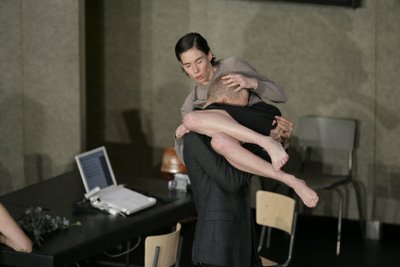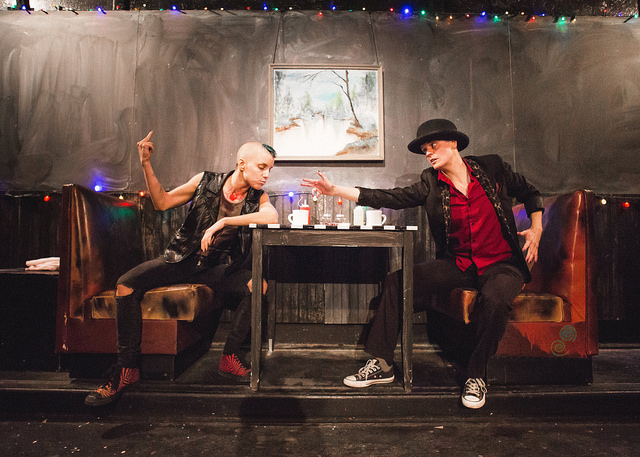The Eugene O’Neill festival now in its final days at Chicago’s Goodman Theatre wasn’t exactly designed as an introduction to this great American playwright. Nor was it a celebration of his best and most famous works. Long Day’s Journey Into Night and The Iceman Cometh were nowhere to be seen on the schedule. But it was a fascinating exploration of O’Neill’s work — filled with unusual and even daring stagings of several plays. Never was it dull, that’s for sure. It ranks up there with the other festivals the Goodman has hosted in recent years focusing on other playwrights, including David Mamet and Edward Albee. (Alas, I missed most of the 2008 festival of plays by Horton Foote, who just passed way.) None of these festivals have been anywhere near comprehensive — that would be just be a huge undertaking for these prolific writers — but they’ve all offered a terrific chance to see plays that aren’t produced all that often.
The full name of the O’Neill festival gives an apt description of what artistic director Robert Falls was going for: “A Global Exploration: Eugene O’Neill in the 21st Century.” It was truly global, with companies from Brazil and the Netherlands performing as well as Chicago and New York theater groups. And it did feel very much like a 21st century interpretation of this quintessentially 20th century playwright.
 The festival ends with director Greg Allen and the Neo-Futurists tackling Strange Interlude, a nine-act, nearly six-hour drama in which the characters speak many of their thoughts aloud. It’s hard to believe this play was one of the biggest commercial hits of O’Neill’s lifetime when it was on Broadway in 1928. Maybe the novelty of it connected with audiences back then. Now, it just seems incredibly ponderous — a script in need of some severe editing. If anyone could pull off a post-modern deconstruction of Strange Interlude, it’s the Neo-Futurists, who did a wonderful show a few years back consisting of the final two minutes of every Ibsen play.
The festival ends with director Greg Allen and the Neo-Futurists tackling Strange Interlude, a nine-act, nearly six-hour drama in which the characters speak many of their thoughts aloud. It’s hard to believe this play was one of the biggest commercial hits of O’Neill’s lifetime when it was on Broadway in 1928. Maybe the novelty of it connected with audiences back then. Now, it just seems incredibly ponderous — a script in need of some severe editing. If anyone could pull off a post-modern deconstruction of Strange Interlude, it’s the Neo-Futurists, who did a wonderful show a few years back consisting of the final two minutes of every Ibsen play.
Their fractured take on Strange Interlude opened Friday night, with just two more performances after that. Amazingly enough, it did seem to hold most of the audience’s attention for its long span — except for that disgruntled purist who caused a disturbance by yelling out his disapproval during the first intermission. I believe he said, “Why are you butchering this play?” or something along those lines. Well, to be honest, it’s a play that deserves a lot of cuts and changes.
The Neo-Futurists played this tragedy for laughs, reading many of O’Neill’s absurdly specific stage directions aloud. The entire performance was a sarcastic commentary on the script itself. And a great deal of it was very funny, with the audience laughing so much at times that the actors had to pause in delivering their lines. The humor went beyond spoofing O’Neill, incorporating some surprising bits of physical humor. What’s really impressive is that the actors and the audience were able to keep up the laughter for almost six hours. Truth to be told, the whole experience would have been easier to absorb if it were condensed down to a third of its length, but then it wouldn’t have been Strange Interlude, would it? Actually, was that play I saw on Friday really Strange Interlude? Perhaps it should have been retitled Stranger Interlude for this occasion.
The headline show of the festival was Desire Under the Elms, directed by Falls and starring Brian Dennehy, Pablo Schreiber and Carla Gugino. (It’s now moving to Broadway.) This turned out to be one of those productions that people either loved or hated. I loved it. Sure, I can see how smaller, less bombastic stagings of O’Neill script work fine, but Fall’s almost operatic epic was staggeringly big. The silent opening sequence showing the brothers hauling boulders was mesmerizing. The actors were intense and passionate. The trims in the script helped the whole story to flow like some fever dream, as Falls said he intended.
The festival also included the Wooster Group’s controversial production of The Emperor Jones, with Kate Valk as the lead character — cross-dressing and in blackface. Why do blackface in 2009? Well, O’Neill’s script has more than its share of dated racial stereotypes, but it is certainly a play of at least some historical interest. So how do you stage it in 2009? The Wooster Group’s solution is a radical sort of commentary on blackface and racial types. The fact that Valk was also changing genders for the role seemed to emphasis that her performance was as much of a comment on the O’Neill play as it was an attempt to transform herself into this character. As a spectacle, the show was an assault on the senses. The play’s language was difficult to follow, but the picture of what I saw onstage will remain in my memory a long time.
The Hypocrites and director Sean Graney performed The Hairy Ape, with an almost frighteningly visceral performance by Chris Sullivan. The play’s message about the gap between the rich and the working class is didactic, but Graney’s staging was just subversive enough that it delivered the message effectively without sarcastically undercutting it. The main thing, though, was Sullivan, whose final moments of blood and torment left me shaken.
I saw two of the three “Sea Plays” performed by the Brazilian group Companhia Triptal, Zona de Guerra (In the Zone and Cardiff (Bound East for Cardiff). (I missed Longa Viagem de Volta pra Casa (The Long Voyage Home).) The actors seemed like real sailors who had somehow become stranded inside this theater thousands of miles from their homes in Sao Paolo. At each of the plays I saw, they were singing sea shanties off stage as the audience came into the theater. Zona de Guerra effectively built up a sense of paranoia among the sailors. Cardiff was an intriguing theatrical adventure — but the lack of supertitles in that show made it difficult to follow along as the actors delivered the dialogue in Portuguese. The audience walked onto the stage for one scene and then went upstairs with the actors into a rehearsal room for the final scene. I enjoyed exploring the Goodman building during this show and watching the expressions on the faces of the actors. I just wish I’d understood what they were saying. I did read the synopsis beforehand, but that’s not the same thing.
 The crowning moment of the whole festival, to me, was another play in a foreign language: Toneelgroep Amsterdam’s Rouw Siert Electra (Mourning Becomes Electra). It helped that the English supertitles were positioned on a wall behind the actors at just the right level to make it easy to read the words and watch the action simultaneously. And the lines were in close synch.
The crowning moment of the whole festival, to me, was another play in a foreign language: Toneelgroep Amsterdam’s Rouw Siert Electra (Mourning Becomes Electra). It helped that the English supertitles were positioned on a wall behind the actors at just the right level to make it easy to read the words and watch the action simultaneously. And the lines were in close synch.
Directed by Ivo Van Hove, this production of Mourning came to Chicago about a week after The New York Times savagely ripped apart a different production of the same O’Neill play in New York. Whatever went wrong with that production, this one in Dutch was utterly amazing. Like many of the other post-modern shows in the Goodman’s O’Neill festival, Mourning had its share of stunts that distanced the audience somewhat from the material. An actor writing and drawing on an overhead projector. Characters exchanging some of their dialogue via instant messaging. The actors beginning each act with a ritual removing of their shoes. These are the sorts of stage devices that literally shout out to the audience, “What you’re watching is just a play!” But the real trick here was that the actors were completely believable, the emotions so deep in their faces and bodies that it was hard to see any line between the character’s skin and the actor inside. The drama came to life in physical gestures — as when one character slaps another, and then slaps again. And again and again. Like a jolt to the audience itself. The entire cast was excellent, but Halina Reijn’s manic-depressive, startlingly transformative performance as Lavinia Mannon deserves singling out. I don’t know when I’ll ever see Reijn or the other actors in this Amsterdam company perform again, but if I get the chance, I won’t miss it.
PHOTOS:
Hans Kesting and Halina Reijn in Rouw Siert Electra (Mourning Becomes Electra). Photo by Jan Versweyveld.
Jeremy Sher, Merrie Greenfield and Joe Dempsey in Strange Interlude. Photo by Eric Y. Exit.


